
Icon for Cosmic Embryo: Erupting star V838 Monocerotis
We have more than enough renewable energy sources to keep every person on earth moving over its surface as much as they might want. For an esoteric example: “On an average day, 60 million square kilometers (23 million square miles) of tropical seas absorb an amount of solar radiation equal in heat content to about 250 billion barrels of oil” (NREL, 2010) (cf. (Bregman et al., 1995)), let alone considering terrestrially falling sunlight, whereas we consume “only” 0.085 billion barrels of oil per day worldwide (NationMaster.com, 2011a).
So why don’t we just quit importing oil cold turkey, i.e., abruptly and completely? The obvious answer is that we haven’t got alternative technologies up and running at the scale needed. From an economics point of view perhaps we can’t afford to do so (Wald, 2009). From an environmental point of view getting off imported oil would increase local drilling, dig into our vast “unconventional oil reserves” (Kovarik, 2007), or use of other fossil fuels, all CO2 producers, and even renewable energy technology is resisted, a sort of a “not in my backyard” approach (Smith&Marquez, 2000; Wolsink, 2000; Jenssen, 2010). The geopolitics would suggest that we can’t afford not to quit.
This topic is not my daily bread and butter, though, of course, I consume the same order ofmagnitude of imported oil as most other North Americans. To do otherwise would be a great inconvenience, primarily because the infrastructure for alternatives is not in place. Yet I feel guilty. If we plot oil exports for the 20 maximally exporting countries versus their democracy ranking, we see two clumps of lower and higher democracy countries (Table 2.1, Figure 2.1). The countries with less democracy export 77% of the oil exports in this group.
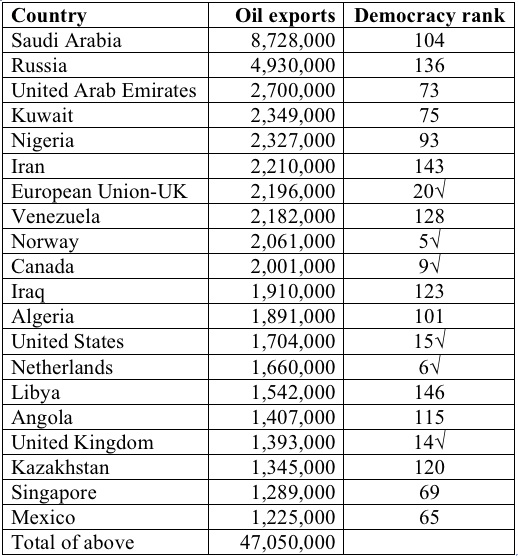
Table 2.1. The first 20 countries in a list of oil exporters (barrels of oil per day), along with their rankings by an index of democracy (1 = most democratic). √ means: in the cluster of higher democracy ranked oil exporting countries in Figure 2.1. Sources: Oil exports in barrels/day: https://www.cia.gov/library/publications/the-world-factbook/rankorder/2176rank.html
Democracy: http://www.worldaudit.org/democracy.htm
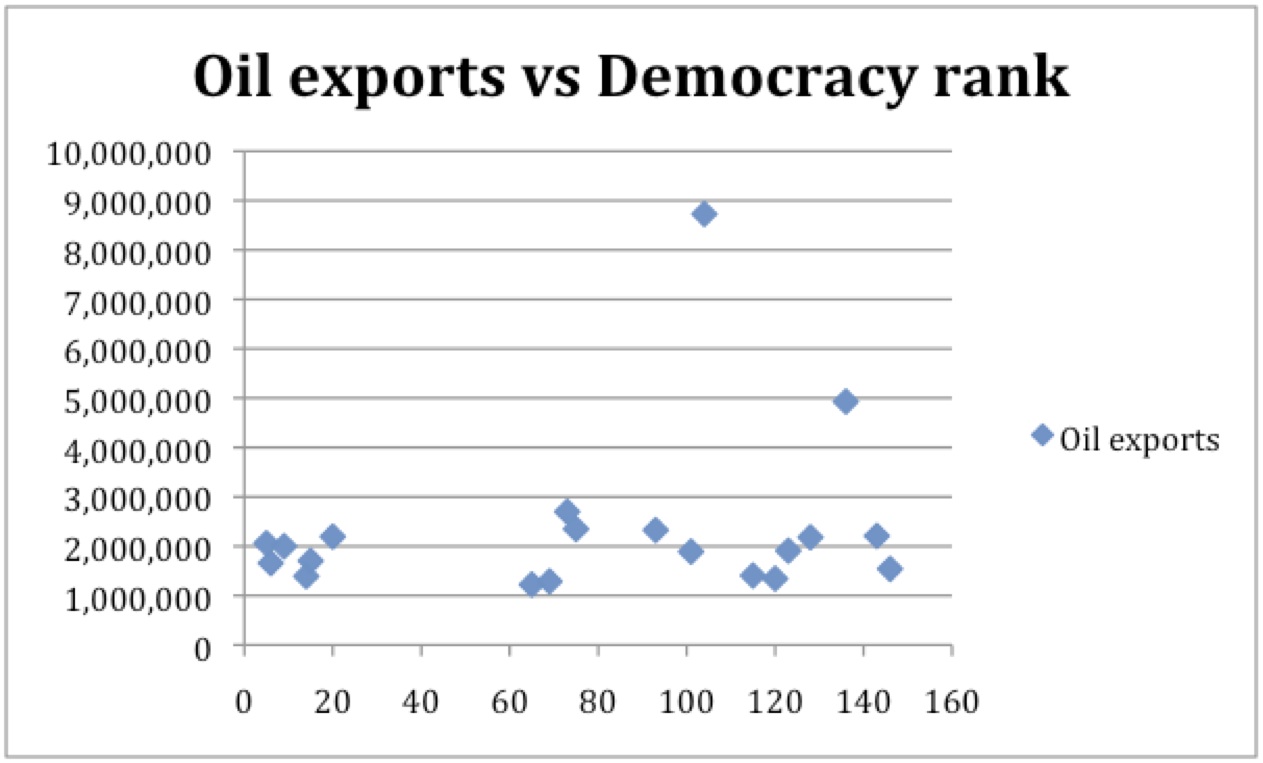
Figure 2.1. Oil exports (barrels/day) versus democracy rank for the 20 countries that export the most oil. Data from Table 2.1.
Since the Snark declared its verdict “Transportation for life!” (Carroll, 1876), we have all been serving that sentence. As no pardon is in sight, what can we do about it? Insofar as the observation that democracies quibble, but don’t go to war against one another is true (Mintz&Geva, 1993; Starr, 1997), we are stalling that state of global nirvana with every drop we pump.
Global warming is also a concern, but given the suggestion that without it the domiciles of many of us would already have been scraped off the surface of the earth by a kilometer high advancing ice sheet (Ruddiman, 2005), and the rush of all countries to approach North American energy consumption rates (Figure 2.2), I dither. Not my battle as a scientist, but one taken up by many others (Gratzer, 2003; Keller, 2007; Essex&McKitrick, 2008; Florides&Christodoulides, 2009).
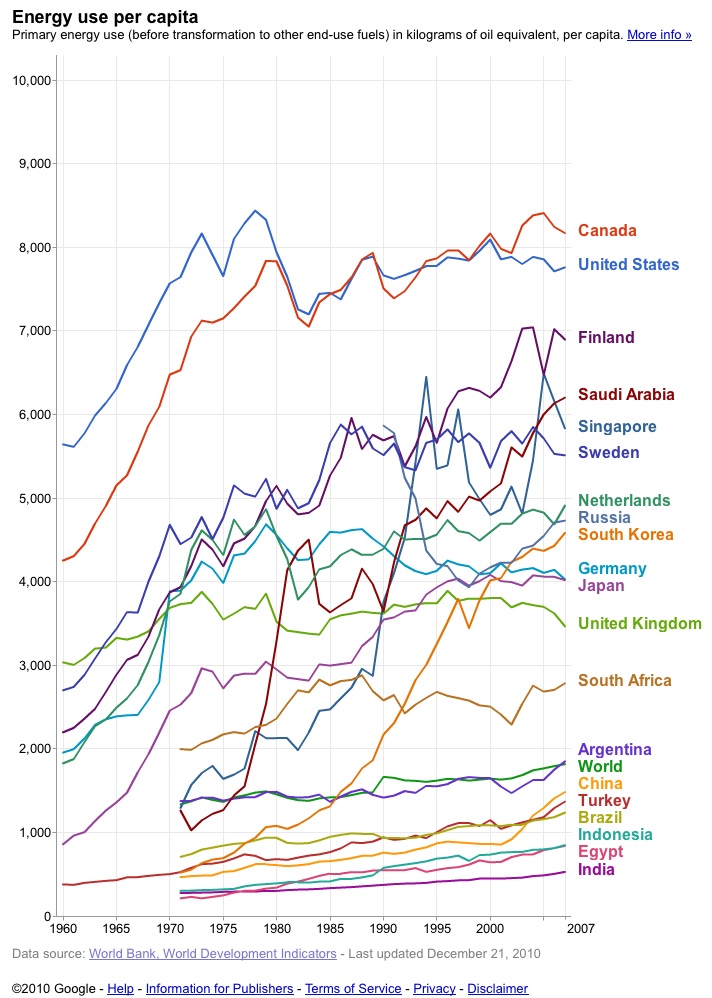
In any case, environmental concerns may have an uphill battle against oil:
“…it's going to be a long time before we run out of oil. There is plenty of it in Venezuela, Canada, Russia and other parts of the world. At current consumption rates, oil
reserve life will be measured in centuries. As consumers we may see this as
good news. Whatever happens in the Middle East, there will be plenty of oil in
the end. As people concerned about the environment, we may see it as very bad
news. Oil will remain cheap for a long time, which may be long enough for
serious damage from climate change” (Kovarik, 2007).
If this long range assessment proves correct, despite current gasoline prices, one great reason for getting off imported oil remains, whether you’re a global warming advocate, denier, or fence sitter: supporting democracy even if it costs more than not doing so. Achieving independence from imported oil feels right.
I backed into the oil issue because I was invited by Janhavi S. Raut to participate in an
in-house conference of Hindustan Unilever Limited in Bangalore, India in 2008, to lecture on diatoms as multiscalar structures for nanotechnology. As this was my first trip to India, it was irresistible. As most of my audience would not have seen a diatom, I broadcast a request on http://www.indiana.edu/~diatom/intro.txt for help with a demonstration, and Karthick B., then a graduate student at the Indian Institute of Science, kindly responded by bringing a microscope and live diatoms. Near the end of my talk I threw in the following two slides out of 177.
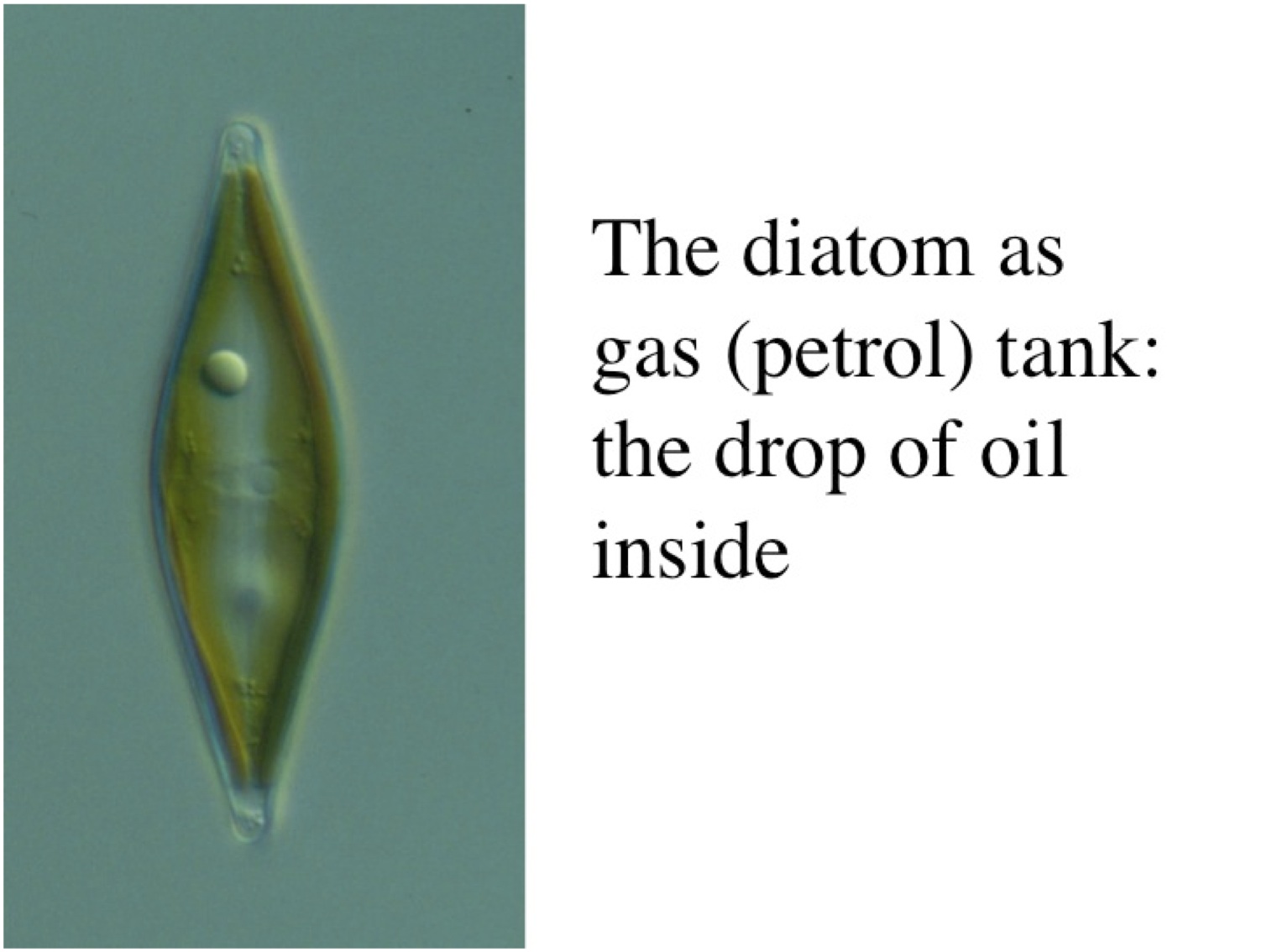
Figure 2.3. Navicula #1 by Charles J. O'Kelly, Bigelow Laboratory for Ocean Sciences http://www.bigelow.org/srs/okelly.html (cobweb site).
No one took the bait. However, when Karthick took me to meet his IIS supervisor, T. V. Ramachandra, and I learned that TVR was a chemical engineer, I casually mentioned the idea and his eyes lit up. We all wrote a paper together, which fulfilled my obligation for a contribution to the proceedings.Sustainable Gasoline
•Geologists attribute crude oil to diatoms
•Diatoms make oil
•Diatom oil production per hectare is 10x that of oil seeds:
•Whittington, T. (2006). Biodiesel Production and Use by Farmers:
Is it Worth Considering? Perth, Department of Agriculture and Food,
Government of Western Australia•http://www.agric.wa.gov.au/content/SUST/BIOFUEL/Onfarmbiodieselprod.pdf.
The idea we introduced, that live, genetically engineered diatoms might secrete gasoline directly in nanostructured solar panels (Ramachandra et al., 2009), is of course but one of many contending ideas on how to get us off imported oil, and eventually perhaps leave the remaining oil in the ground. If it works, it has the advantages of local, even home production of gasoline on every rooftop, with no change needed to automobile engines. Secretion solves the problems of grinding up algae to remove the oil, and of stimulating them to make more oil. The dairy industry does not work by grinding up cows and separating out the milk, nor should we treat algal cells so rudely. Diatom oil production is prophesied to be 7 to 200x compared to oilseed crops (Sheehan et al., 1998; Hu et al., 2008; Demirbas, 2009). I’ve guesstimated that 10 square meters of gasoline secreting solar panels per person might do the trick for North Americans (Gordon et al., 2010) (who, however, are not the highest per capita consumers of oil (NationMaster.com, 2011b)).
One advantage of being a theoretical biologist is that you leave the development of your (good) ideas to others. Moreover, theoretical biologists do not get the respect and adoration that theoretical physicists do, and so while we are generally ignored, we are also allowed to plod on out of the public eye. We furthermore get to make outlandish proposals without a lot of scrutiny, grandly offering experimentalists the opportunity to do the hard work of testing our ideas. It’s a good life.
I agreed to co-edit a volume on algal fuels with Joseph Seckbach, for which I dabbled in international affairs with a typical outlandish idea: the USA (or other countries like India) could just set a date after which they would import no more oil (Gordon, 2011).
Now I’m no economist, nor adept at geopolitical gamesmanship. People in those fields can cringe in horror at the idea of quitting imported oil cold turkey. For environmentalists, quitting imports cold turkey would indeed mean swallowing an immediate, but perhaps temporary, increased reliance on local fossil fuels. But I’m old enough to be aware of the World War II story of how the USA, in 1.5 years, recovered from being suddenly cut off from most natural rubber sources with the invasion of the South Pacific by Japan, and accomplished mass production of artificial rubber just before stockpiles ran out (Gordon, 2011). It was quite a feat. In the case of imported oil, the USA could decide in advance when it would stop the practice, and get ready for the big day.
One might predict that the USA would surge forward with new technologies, that the price of oil would plunge, that the economies of China and India would thereby benefit, that the power of the non-democracies would decrease, and we would all live happily ever after. One could also argue against any of these flimsy predictions. However, the bottom line is that the USA is spending $0.7 trillion per year on imported oil (National Algae Association: http://www.nationalalgaeassociation.com/Events.html) that could be invested inside the USA instead.
Right now investment in alternative energy sources may be going up and down with the price of imported oil (van Vuuren&Riahi, 2008; Hohler et al., 2010) (Figure 2.4), which manipulated or not (Aune et al., 2010), makes it tough for startup companies to survive. Quitting cold turkey could create a level playing field for every alternative energy source to compete and show its mettle. Such competition might ultimately be more efficient than central planning (Lund&Mathiesen, 2009).
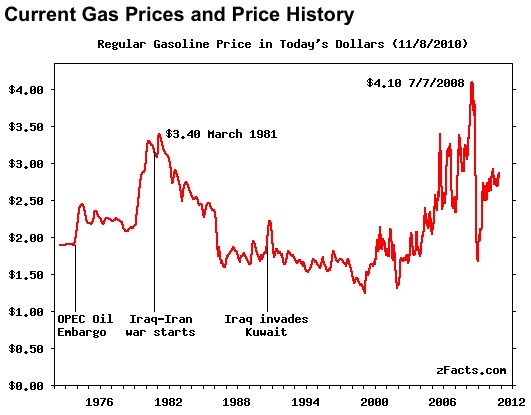
Figure 2.4. Fluctuations in USA cost of regular gasoline, which may exasperate investment in alternative fuels. From http://zfacts.com/p/35.html, based on Department of Energy data.
After our paper appeared (Ramachandra et al., 2009), we learned that Exxon had given Craig Venter $600 million (Swift, 2009; LeVine, 2010) to develop a secreted algal fuel (Ladd&Venter, 2008), so our modest academic proposal has Goliath commercial competition. Venter’s project differs from ours in a number of aspects besides relative funding. While it is touted in an often played Exxon TV commercial, details are kept secret as far as I can tell: no publications nor patents yet. From his Internet interviews and the ad, it seems based on centralized algal culture in transparent tubular structures leading to a crude oil that may prove more valuable to investors for producing petroleum products such as plastics than gasoline (LeVine, 2010). It requires concentrated sources of carbon dioxide, and thus depends on CO2 production or capture (Brahic&Venter, 2009), which might prove a step backwards. But we can expect that the organisms will be patented, and that big oil companies like Exxon will attempt to survive a transition off their main business by harvesting our free sunlight and selling it to us. Skeptics are speaking out (Jackson, 2009), but I suspect Venter has unstated answers to their objections. Secrecy is endemic to the algal fuel industry.
Just try finding out what species each company is using.
Given Venter’s track record on the human genome project, he’sundoubtedly well out of the startup gate on secreted oil, and perhaps we should let him run the race alone. But we have a wonderful example of the development of the free Linux and GNU (Stallman, 1985; Wikipedia Contributors, 2011) operating system for computers as a distributed effort by hundreds of volunteer computer scientists and programmers contributing over 60,000 people-years of work (Kelly, 2010). Perhaps an “open source” approach to inventing distributed oil production, such as might be possible with gasoline secreting diatom solar panels or other approaches, is worth trying:
Hundreds of Davids working together versus the Goliaths of the oil industry just might“I don’t see much about the larger problem of how we are going to replace petroleum in the international economy over the long term. I mean, is it even possible? Who has thought of it? How can we get ‘beyond rhetoric’ and think about really getting ‘beyond petroleum’? Why is it that the social construction of energy technology is so much more difficult than the social construction of, say, computing and the digital media revolution? Was IBM that much less of a challenge than Standard Oil? Where are the Steve Wozniaks of the energy revolution?” (Bill Kovarik as quoted in (Davidson, 2010)).
hasten the day, perhaps faster than the 10 years Venter has given himself to reach this goal. Cooperation without secrecy allowed the USA to succeed in replacing natural with artificial rubber in 1.5 years. Perhaps we’re ready for a repeat performance, one that smacks of the democracy that the world needs lots more of.
References
Aune, F.R., K. Mohn, P. Osmundsen&K.E. Rosendahl (2010). Financial market pressure, tacit collusion and oil price formation. Energy Economics 32(2), 389-398.
Brahic, C.&C. Venter (2009). One-minute interview Renewable oilman. New Scientist 203(2718), 25-25.
Bregman, R., R.H. Knapp&P.K. Takahashi (1995). Design considerations for ocean energy resource systems. In: OCEANS 95 MTS/IEEE Conference on Challenges of Our Changing Global Environment, Oct 9-12, 1995, San Diego, California, Conference Proceedings. Eds., IEEE: 1084-1091.
Carroll, L. (1876). The Hunting of the Snark: An Agony in Eight Fits. New York, Macmillan.
Davidson, O.G. (2010). Where are the Steve Wozniaks of the energy revolution? , http://trueslant.com/oshagraydavidson/2010/05/30/where-are-the-steve-wozniaks-of-the-energy-revolution/.
Demirbas, A. (2009). Progress and recent trends in biodiesel fuels. Energy Conv. Manag. 50, 14-34.
Essex, C.&R. McKitrick (2008). Taken By Storm, Key Porter Books, Revised.
Florides, G.A.&P. Christodoulides (2009). Global warming and carbon dioxide through sciences. Environ Int 35(2), 390-401.
Gordon, R., A. Witkowski, I.C. Gebeshuber & C.S. Allen (2010). The diatoms of Antarctica and their potential roles in nanotechnology. In: Antarctica: Time of Change. Eds.: M. Masó. Barcelona, Editions ACTAR: 84-95.
Gordon, R. (2011). Quitting cold turkey: rapid oil independence for the USA. In: The Science of Algal Fuels: Phycology, Geology, Biophotonics, Genomics and Nanotechnology. Eds.: R. Gordon & J. Seckbach. Dordrecht, Springer: accepted, gordonr@cc.umanitoba.ca.
Gratzer, W. (2003). A healthy draught of scepticism, Review of: Eight Preposterous Propositions: From the Genetics of Homosexuality to the Benefits of Global Warming, by Robert Ehrlich, Princeton University Press. Nature 426(6968), 766-767.
Hohler, A., A. Tyne, F.B. Fadhl, N. Aspinall, R. Greenwood & R. Boyle (2010). Global Trends in Sustainable Energy Investment 2010: Analysis of Trends and Issues in the Financing of Renewable Energy and Energy Efficiency, United Nations Environment Programme and New Energy Finance.
Hu, Q., M. Sommerfeld, E. Jarvis, M. Ghirardi, M. Posewitz, M. Seibert & A. Darzins (2008). Microalgal triacylglycerols as feedstocks for biofuel production: perspectives and advances. Plant Journal 54(4), 621-639.
Jackson, J. (2009). Reactions are coming in now to the $600 million investment of Exxon in partnership with Venter's start up, Synthetic Genomics. http://groups.google.com/group/diybio/browse_frm/thread/c031b6d8c9c4dc1e?tvc=1.
Jenssen, T. (2010). The good, the bad, and the ugly: acceptance and opposition as keys to bioenergy technologies. Journal of Urban Technology 17(2), 99-115.
Keller, C.F. (2007). Global warming 2007. An update to global warming: the balance of evidence and its policy implications. ScientificWorldJournal 7, 381-399.
Kelly, K. (2010). What Technology Wants, Penguin Group USA.
Kovarik, B. (2007). Peak Oil is wrong: The Oil Reserve Fallacy. Proven reserves are not a measure of future supply. http://www.radford.edu/~wkovarik/oil/.
Ladd, C. & J.C. Venter. (2008). 10 Big Questions for Maverick Geneticist J. Craig Venter on America's Energy Future. http://www.popularmechanics.com/blogs/science_news/4275738.html.
LeVine, S. (2010). Craig Venter's one-man algae fuels bubble. http://oilandglory.foreignpolicy.com/posts/2010/09/07/craig_venters_one_man_algae_fuels_bubble_0.
Lund, H. & B.V. Mathiesen (2009). Energy system analysis of 100% renewable energy systems -- the case of Denmark in years 2030 and 2050. Energy 34(5), 524-531.
Mintz, A. & N. Geva (1993). Why don't democracies fight each other? An experimental study. Journal of Conflict Resolution 37(3), 484.
NationMaster.com. (2011a). Energy Statistics >Oil > Consumption (most recent) by country http://www.nationmaster.com/graph/ene_oil_con-energy-oil-consumption.
NationMaster.com. (2011b). Energy Statistics > Oil > Consumption (per capita) (most recent) by country. http://www.nationmaster.com/graph/ene_oil_con_percap-energy-oil-consumption-per-capita.
NREL. (2010). Ocean Thermal Energy Conversion. http://www.nrel.gov/otec/what.html.
Ramachandra, T.V., D.M. Mahapatra, Karthick B. & R. Gordon (2009). Milking diatoms for sustainable energy: biochemical engineering versus gasoline-secreting diatom solar panels. Industrial & Engineering Chemistry Research 48(19, Complex Materials II special issue, October), 8769-8788.
Starr, H. (1997). Democracy and integration: why democracies don't fight each other. Journal of Peace Research 34(2), 153-162.
Swift, T. (2009). J. Craig Venter. http://topics.nytimes.com/top/reference/timestopics/people/v/j_craig_venter/index.html.
van Vuuren, D. & K. Riahi (2008). Do recent emission trends imply higher emissions forever? Climatic Change 91, 237-248.
Wald, M.L. (2009). Cost works against alternative and renewable energy sources in time of recession. http://www.nytimes.com/2009/03/29/business/energy-environment/29renew.html.
Wikipedia Contributors. (2011). Free and open source software. http://en.wikipedia.org/wiki/Free_and_open_source_software.
Wolsink, M. (2000). Wind power and the NIMBY-myth: institutional capacity and the limited significance of public support. Renewable Energy 21(1), 49-64.
Stallman, R. (1985). The GNU Manifesto. http://www.gnu.org/gnu/manifesto.html.Smith, E. & M. Marquez (2000). The other side of the NIMBY syndrome. Society & Natural Resources 13(3), 273-280.Sheehan, J., T. Dunahay, J. Benemann & P. Roessler (1998). A Look Back at the U.S. Department of Energy’s Aquatic Species Program: Biodiesel from Algae. Close-Out Report [NREL/TP-580-24190]. Golden, Colorado, National Renewable Energy Laboratory.Ruddiman, W.E. (2005). How did humans first alter global climate? Scientific American 292(3), 46-53.




Comments